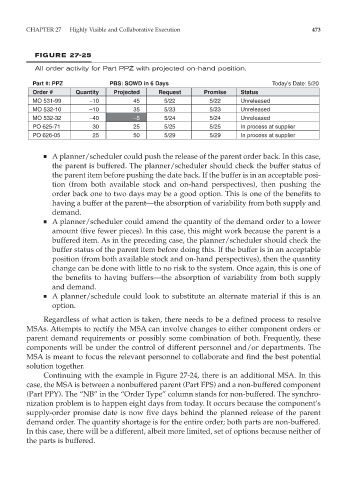Page 496 - Orlicky's Material Requirements Planning
P. 496
CHAPTER 27 Highly Visible and Collaborative Execution 473
FIGURE 27-25
All order activity for Part PPZ with projected on-hand position.
Part #: PPZ PBS: SOWD in 6 Days Today’s Date: 5/20
Order # Quantity Projected Request Promise Status
MO 531-99 –10 45 5/22 5/22 Unreleased
MO 532-10 –10 35 5/23 5/23 Unreleased
MO 532-32 –40 –5 5/24 5/24 Unreleased
PO 625-71 30 25 5/25 5/25 In process at supplier
PO 626-05 25 50 5/29 5/29 In process at supplier
■ A planner/scheduler could push the release of the parent order back. In this case,
the parent is buffered. The planner/scheduler should check the buffer status of
the parent item before pushing the date back. If the buffer is in an acceptable posi-
tion (from both available stock and on-hand perspectives), then pushing the
order back one to two days may be a good option. This is one of the benefits to
having a buffer at the parent—the absorption of variability from both supply and
demand.
■ A planner/scheduler could amend the quantity of the demand order to a lower
amount (five fewer pieces). In this case, this might work because the parent is a
buffered item. As in the preceding case, the planner/scheduler should check the
buffer status of the parent item before doing this. If the buffer is in an acceptable
position (from both available stock and on-hand perspectives), then the quantity
change can be done with little to no risk to the system. Once again, this is one of
the benefits to having buffers—the absorption of variability from both supply
and demand.
■ A planner/schedule could look to substitute an alternate material if this is an
option.
Regardless of what action is taken, there needs to be a defined process to resolve
MSAs. Attempts to rectify the MSA can involve changes to either component orders or
parent demand requirements or possibly some combination of both. Frequently, these
components will be under the control of different personnel and/or departments. The
MSA is meant to focus the relevant personnel to collaborate and find the best potential
solution together.
Continuing with the example in Figure 27-24, there is an additional MSA. In this
case, the MSA is between a nonbuffered parent (Part FPS) and a non-buffered component
(Part PPY). The “NB” in the “Order Type” column stands for non-buffered. The synchro-
nization problem is to happen eight days from today. It occurs because the component’s
supply-order promise date is now five days behind the planned release of the parent
demand order. The quantity shortage is for the entire order; both parts are non-buffered.
In this case, there will be a different, albeit more limited, set of options because neither of
the parts is buffered.

